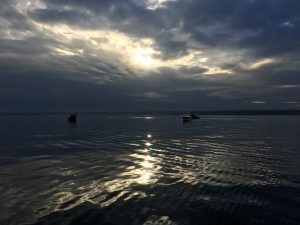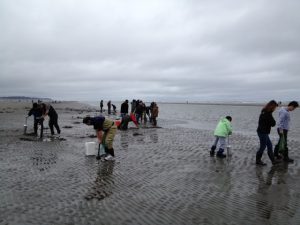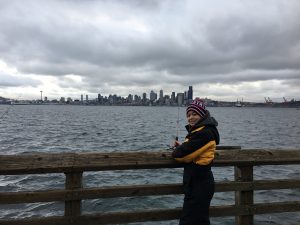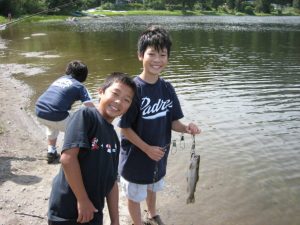Top picks to burn off Thanksgiving calories are salmon in open marine areas and razor clams on coast Leave a reply
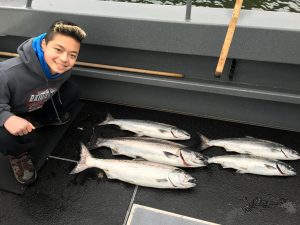
Will salmon anglers find success like this catch of winter chinook in Areas 8-1 and 8-2? Or will it be “shaker” city?
Salmon anglers are eagerly waiting for this Saturday’s reopening of Marine Catch Area 8-1 and 8-2 for hatchery chinook, which covers the entire 58 miles of the eastern side of Whidbey Island.
Many will be targeting hatchery blackmouth – a term used for chinook for their dark gumline – in Areas 8-1 and 8-2 at Elger Bay, Onamac Point, Camano Head, Hat Island, East Point and Sandy Point on southeast corner of Whidbey Island, Baby Island and Rocky Point on northwest corner of Camano Island.
One great way to gauge how success will be since chinook fishing in Areas 8-1 and 8-2 has been closed for a long time is the Everett Salmon & Steelhead Club and Puget Sound Anglers Salmon Derby on Saturday and Sunday (Dec. 1-2). The derby headquarters will be Bayside Marine in Everett. Cost for the Everett Steelhead & Salmon Club’s side pot is $10, and Puget Sound Anglers side pot is $100 per boat. Weigh-in station is the Everett boat launch on Saturday at 4 p.m. and Sunday between 12:30-1 p.m. You must be in line by 1 p.m. There will be a potluck on Sunday. Details: 425-530-0017 or 4salebydavemiller@gmail.com or 425-501-4024 or 206-730-0469 or rgarner@aol.com.
“Sticking to the baitfish and locating them is key during the winter blackmouth fisheries as their always looking for the feed,” said Justin Wong, the owner of Cut Plug Charter in Seattle.
Your fish-finder is a valuable tool to finding schools of bait and once you locate the herring and candlefish be sure to stay right on top of them.
Understanding tidal movements is another key factor in catching winter chinook and is more vital than being out before daybreak like you would during the summer time. Doing some homework on underwater structures will pay off as on certain tidal movements the baitfish will push up against the deep shelfs, and drop-offs and ledges allowing hungry blackmouth to easily find their prey.
I’ll the follow advice Gary Krein, owner of All-Star Charters in Seattle, provided and that is the fish tend to be more predictable so if the bite occurred at a certain time of the day, it’s most likely they’ll do the same the following day only an hour later.
My third tip for salmon anglers is to never keep your bait or lure in the upper water column and think “deep” as winter chinook tend to hang right off the bottom digging their noses in the sand looking for bait like candlefish or picking off schools of herring.
The other two marine areas currently open for salmon fishing are south-central Puget Sound (11); Hood Canal (12); and southern Puget Sound (13).
In recent days the bite around the Clay Banks off Point Defiance Park in Tacoma, the “Flats” outside of Gig Harbor, Quartermaster Harbor and Point Dalco on south side of Vashon Island has been fair at time. In fact, a WDFW fish check from Sunday at the Point Defiance Park Boathouse in Tacoma showed nine boats with 12 anglers taking home five chinook and one chum.
Other areas to look for winter chinook in Areas 11 and 13 are south of the Southworth Ferry Landing; Colvos Passage off the Girl Scout Camp; Brace Point; Three Tree Point; Fox Point; Point Fosdick; Anderson Island; Lyle Point; and Devil’s Head and Johnson Point.
The sleeper spot that doesn’t garner as much attention during the winter is Hood Canal (Area 12). This winter fishery is also currently open and look for hungry blackmouth around Misery Point, Hazel Point, Pleasant Harbor, Toandos Peninsula, Seabeck Bay and Seal Rock.
Keep in mind closing dates on many fishing areas could hinge on chinook catch guidelines or encounter limits for both sub-legal and legal-size chinook.
Anglers more than a month to soak their pots for Dungeness crab, and reports are fairly good despite summer catch assessments being the lowest dating back to 2008.
Marine areas open daily through Dec. 31 are Neah Bay east of the Bonilla-Tatoosh line (Area 4); Sekiu in western Strait of Juan de Fuca (5); Port Angeles in eastern Strait of Juan de Fuca (6); San Juan Islands (7); Deception Pass, Hope Island and Skagit Bay (8-1); Port Susan and Port Gardner (8-2); and a section of northern Puget Sound/Admiralty Inlet (9) except for waters south of a line from Olele Point to Foulweather Bluff.
Central Puget Sound (10), south-central Puget Sound (11); Hood Canal (12); and southern Puget Sound (13) remain closed this winter.
The daily limit in Puget Sound/Strait sport fisheries is five Dungeness crab – male crab only – in hard shell condition with a minimum carapace width of 6 ¼ inches. Crabbers may also catch six red rock crab of either sex per day with a minimum carapace width of 5 inches.
All Dungeness crab caught in the late-season recreational fishery must be recorded immediately on winter catch record cards, which are valid through Dec. 31.
Word on razor clam digs
Ideal weather and surf conditions created some excellent razor clam digging from Nov. 22-25 on open coastal beaches.
“It was a very successful Thanksgiving weekend, and there was a total of 16,500 digger trips and just shy of 230,000 clams harvested (at Twin Harbors, Copalis and Mocrocks),” said Dan Ayres, the WDFW head coastal shellfish manager.
Diggers at Twin Harbors averaged 12.8 clams per person (the first 15 clams dug regardless of size or condition is a daily limit) on Nov. 22-25. At Copalis the average was 14.7 on Nov. 21 and 24; and at Mocrocks it was 14.5 on Nov. 23-24.
The size of clams overall was just shy of 4 1/2 inches although clam size varied depending where people dug.
All digs hinge on marine toxin test results for domoic acid — a natural marine toxin produced by certain types of marine algae that can be harmful or even fatal if consumed in sufficient quantities. So far, all beaches test results remain well under the action level of 20 parts per million.
WDFW will make a final announcement on the next series of digs either Tuesday (Nov. 27) or Wednesday (Nov. 28).
Tentative clam digs are planned for Dec. 6 and 8 at Twin Harbors and Copalis; and Dec. 7 and 9 at Twin Harbors and Mocrocks. Additional digs will occur right before Christmas on Dec. 20 at Twin Harbors and Mocrocks; Dec. 21 and 23 at Twin Harbors and Copalis; and Dec. 22 at Long Beach, Twin Harbors and Mocrocks.
Squid jigging takes a momentary nose dive
Squid jigging started off on a hit note back in September through October, but in recent weeks has taken a dip in success.
I wouldn’t write off the season just yet as the peak timing of the migration of millions of squid usually occurs in December and January.
Night-time on a flood tide is time to catch squid that are attracted to light beaming off the piers as well as those who bring their own powerful lanterns to dangle just off the surface of the water.
Schools of squid will lurk along the shadowy edges of lighted water and then quickly dart out into the light on their unsuspecting prey.
Look for 4- to 8-inch squid at the Seacrest Pier in West Seattle; along the Seattle waterfront including Piers 57, 62, 63, 70 or the Seattle Aquarium Pier. One of the top locations was Pier 86 off Elliott Avenue although it has been closed since 2017 until further notice due safety concerns.
Other Puget Sound locations are the Edmonds Pier; Des Moines Pier; Redondo Pier; A-Dock and Shilshole Pier; Point Defiance Park Pier; Les Davis Pier in Tacoma; Fauntleroy Ferry Dock; Illahee State Park Pier; and the Waterman and Indianola piers in Kitsap County.
Trout fishing action decent
Nice weather and oodles of trout tugging on the end of their lines greeted anglers on many year-round lakes in the western Washington region during the Thanksgiving holiday.
The “Fish Black Friday” has become an annual tradition for anglers as WDFW plants of thousands of trout averaging 15 to 16 inches and weighing up to 3 pounds.
Good fishing was even found ahead of Thanksgiving at places like Beaver Lake in Issaquah that was planted with a second round of 894 rainbow trout averaging 1.5 pounds apiece.
Beaver will receive another blast of around 800 trout during the third week of December that should keep anglers happy well beyond the Christmas holiday.
Others recently planted that provided fair to good action this past weekend were Battle Ground (2,000 trout planted) and Klineline Pond (2,010) in Clark County; Kress (2,400) in Cowlitz County; Fort Borst Park (1,200) and South Lewis County (2,000) in Lewis County; American (2,.058) and Tanwax (1,103) in Pierce County; Black (3,000), Long (1,222) and Offutt (1,234) in Thurston County; Rowland (2,043) in Klickitat County; North Elton (2,000) in Yakima County; and Cases (570) in Pacific County.
Good choices east of the Cascades also include Hatch and Williams in Stevens County; Fourth of July in Lincoln/Adam counties; and Hog Canyon in Spokane County.
A quick peek ahead that anglers should keep on their “must do” list is Lake Goodwin northwest of Marysville, which will get a mid-December plant of 5,000 trout.
Recent trout plants also occurred at Blackman’s Lake; Gissburg Ponds North and South; Kapowsin, Bonney, Bradley, Tanwax and Harts in Pierce County; Padden in Whatcom; and Campbell south of Anacortes.
For a complete list of planted lakes, go to https://wdfw.wa.gov/fishing/fall-into-fishing/.


